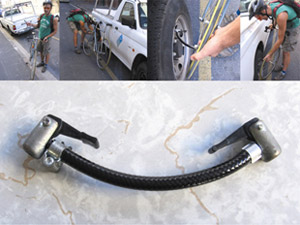| RalphBorland.net | ||
| Disruptive Design Team - Introduction Projects & People | ||
|
||
|
In October 2006 I left Cape Town, South Africa, and started my PhD at Trinity College, Dublin, with the Disruptive Design Team (DDT). The DDT is a cross-disciplinary research group in the Electronic and Electrical Engineering Department, headed by Linda Doyle, my supervisor. My initial connection to the group was through Jonah Brucker-Cohen, who studied at the Interactive Telecommunications Program (ITP) at New York University the year ahead of me, via Nathaniel Stern, my class-mate at ITP who spoke to me about the DDT after visiting Jonah here. Nathaniel and I both joined the group in 2006.
The attraction of working here, for me, is to pursue art production, technology development and analysis, and activist work together. I'm interested in the idea of 'provocative technology': tools and technologies that combine the attributes of art and design objects - objects that may have an immediate function to perform, but that also serve as pointers, that communicate concepts around their use and the social conditions that make them necessary. My project 'Suited for Subversion' started me thinking in this way a few years back; it's a padded suit designed both to protect a protestor from police, but also to convey ideas about protest. Another artist who works in this terrain is Michael Rakowitz; his project 'paraSite' saw him designing and constructing ingenious shelters for homeless individuals in Boston and New York. They are made of cheap plastic sheeting, and attach to the heating ducts of buildings so that the waste hot air both warms and gives structure to the dwellings. As immediately functional as the shelters are, the project does not present itself as a solution, but rather as "an agitational device". The paraSite is meant as a conspicuous social protest and not as a long-term solution to homelessness - "It is very much an intervention that should become obsolete. These shelters should disappear like the problem should. In this case the real designers are the policymakers" (M. Rakowitz). This idea of design as pointer to a problem, and as disposable once the problem is addressed, is carried in a past 'statement of purpose' by the Interrogative Design Group from MIT: "A bandage covers and treats the wound while at the same time exposing its presence. Its presence signifies both the experience of pain and the hope of recovery. Is it possible to further develop such a bandage as equipment that will communicate, interrogate, and articulate the circumstances and the experience of the injury? Could such a transformed bandage address the ills of the outside world as perceived by the wounded? To see the world as seen by the wound!" My work while with the DDT will be to develop projects that address social issues through creative means, and at the same time to look at the politics of technology - what technologies are promoted by which groups, and how issues around the direction of technological development can be communicated to a public. I will be documenting the development of my research on this site. I've started listing some of the projects and people I'm looking at... |

